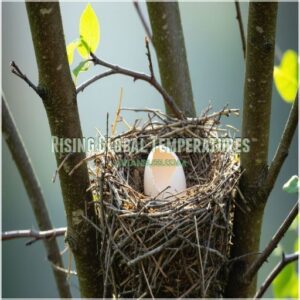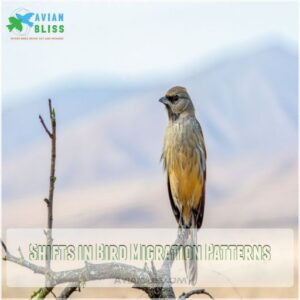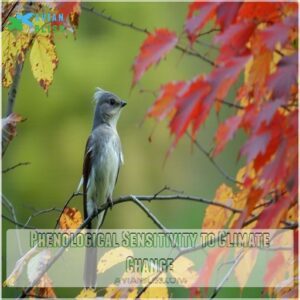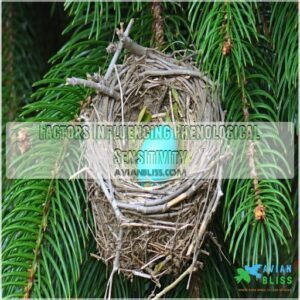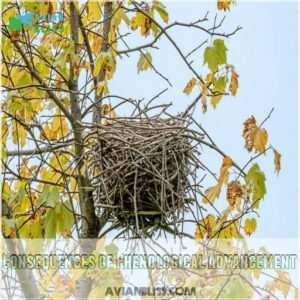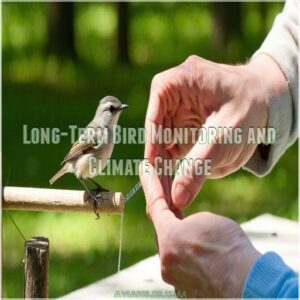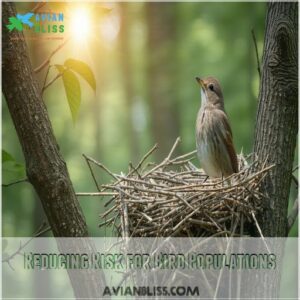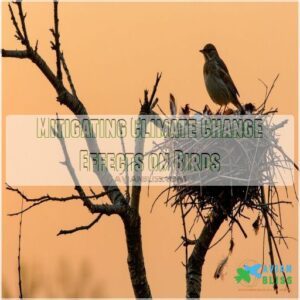This site is supported by our readers. We may earn a commission, at no cost to you, if you purchase through links.
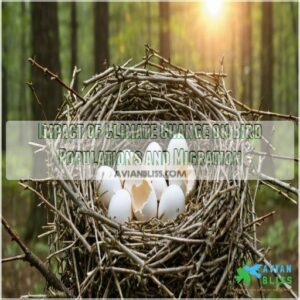
Rising global temperatures are reshuffling migration patterns, making some birds miss the memo on when to fly. This can lead to mismatches in food availability, like when a bird arrives to an empty dinner plate.
Breeding habits are shifting too, with birds nesting earlier than usual, sometimes affecting chick survival.
And while some adapt, others face increased extinction risks.
The changes in their environments—like altered snow cover and shifting prey abundance—pose real challenges.
What strategies can help these feathered friends navigate global warming’s stormy skies?
Table Of Contents
- Key Takeaways
- Impact of Climate Change on Birds
- Climate Change Effects on Bird Populations
- Phenological Sensitivity to Climate Change
- Factors Influencing Phenological Sensitivity
- Consequences of Phenological Advancement
- Threats to Bird Populations From Climate Change
- Long-Term Bird Monitoring and Climate Change
- Reducing Risk for Bird Populations
- Climate Change Impacts on Bird Distribution
- Mitigating Climate Change Effects on Birds
- Frequently Asked Questions (FAQs)
- How does climate change affect the population of birds?
- How would climate change adjust the range of these birds?
- What is the biggest threat to bird populations?
- Which of the following are changes seen in bird populations because of global warming?
- How does climate change affect bird migration?
- What role does habitat loss play in bird decline?
- How are specific bird species adapting to climate change?
- Can urban areas provide safe havens for birds?
- How do changing weather patterns impact bird survival?
- Conclusion
Key Takeaways
- You’ll find that climate change significantly alters bird migration patterns and breeding cycles, impacting food availability and survival rates.
- You should know that rising temperatures cause phenological mismatches, where birds’ breeding times no longer align with peak food availability, decreasing reproductive success.
- You’ll discover that habitat loss and changes in food resources due to climate change increase extinction risks for many bird species.
- You can help by supporting conservation efforts like habitat restoration and participating in citizen science projects to gather crucial data for informed decision-making.
Impact of Climate Change on Birds
You’ll find that climate change has a big impact on birds, altering their habitats and food sources.
These changes affect their migration patterns, breeding cycles, and overall population numbers, leading to potential declines in various species.
Rising Global Temperatures
How do rising global temperatures impact birds?
Extreme weather and heat waves increase stress, affecting their survival rates.
Climate change leads to temperature rises, causing phenology shifts, such as breeding earlier in the season.
These changes can drive species toward extinction, particularly those unable to adapt quickly.
Warming temperatures also disrupt food availability, posing a significant threat to bird populations worldwide.
Shifts in Bird Migration Patterns
As global temperatures rise, birds find their migration patterns shifting faster than ever.
Imagine migrating birds checking the calendar and realizing their stopover sites and breeding grounds are changing.
These shifts in migration timing and flight paths reflect their phenological sensitivity to climate change.
Birds are adapting, postponing their arrival dates, adjusting to warmer climates, and seeking freedom in new ranges.
Changes in Breeding Habits
Bird breeding habits are as unpredictable as the weather these days. Rising temperatures have birds struggling with nesting timing, clutch size, and breeding success. This is especially true for birds like the American Kestrel, where climate change alters breeding timing. Here’s what’s happening:
- Birds adjust laying dates based on temperature cues.
- Phenological advancement affects food availability during breeding season.
- Changes in habitat selection impact phenological sensitivity.
It’s a challenging environment for our feathered friends.
Climate Change Effects on Bird Populations
Climate change is reshaping our feathered friends’ world, and bird populations are feeling the heat.
Rising temperatures and habitat loss are causing avian decline, pushing species toward extinction.
Many flock to higher altitudes or latitudes to adapt, but not all can keep pace.
Conservation strategies and climate change adaptation play vital roles in safeguarding these birds.
For instance, strategies like protected areas safeguarding millions of acres have proven effective in fostering biodiversity.
Citizen science projects and data analysis reveal startling trends, guiding efforts to curb habitat loss.
Here’s a quick look at how climate change impacts birds:
| Climate Impact | Description |
|---|---|
| Temperature Rise | Alters migration patterns |
| Habitat Loss | Leads to species decline |
| Conservation Needs | Urgent for survival strategies |
Your role in conservation can make a lasting difference.
Phenological Sensitivity to Climate Change
You’ll notice that bird populations in deciduous forests show stronger responses to climate changes compared to those in evergreen areas.
These variations are due to habitat differences, temperature cues, and food availability, affecting how birds adapt to their environments.
Variations Across Habitats
We’ve seen how climate change impacts bird populations.
Now, let’s look at how these effects vary depending on where birds live.
Habitat type strongly influences a bird’s response.
Deciduous forests, for example, offer different food resources and nesting sites compared to evergreen forests.
These habitat-specific adaptations mean some birds are more sensitive to temperature shifts than others.
Phenological differences arise from these habitat variations, affecting breeding success and food availability.
Understanding these habitat-driven changes is key to protecting our feathered friends.
Temperature Windows and Latitudinal Patterns
Temperature windows show a nifty dance with latitudinal patterns.
As you move north, temperature cues naturally shift later in the year, affecting phenological timing in birds.
These shifts dictate changes in breeding range and have widespread climate change impacts.
Wherever you look, habitat effects are a big player in these changes, reminding us of nature’s intricate balancing act.
Dietary Differences and Peak Caterpillar Abundance
Birds’ diets often hinge on caterpillar abundance, essential for breeding success.
In deciduous forests, peak caterpillar availability aligns with nesting needs, but evergreen habitats show wider, less predictable peaks.
This dietary mismatch can lead to phenological mismatches, impacting food resources and breeding success.
Understanding these dietary specializations helps assess how climate change shifts food availability and affects bird populations.
Factors Influencing Phenological Sensitivity
When considering bird populations, you might notice that the type of habitat greatly affects how sensitive these birds are to changes in timing due to climate change.
In evergreen forests, temperature cues can be less reliable, but higher annual precipitation usually makes birds more sensitive to these phenological shifts.
Habitat Type and Climate Change Exposure
Habitat variation influences phenological sensitivity, with different types affecting how birds respond to climate change.
Deciduous habitats aid adaptation as resource availability aligns better with temperature increases.
Evergreen areas, with less predictable resources, pose challenges for avian adaptation.
This impacts conservation efforts as species extinction risks heighten with perpetuating habitat loss and climate change, demanding informed strategies.
Role of Temperature Cues in Evergreen Habitats
Evergreen habitats might fool you with their steady green, but they’re a wildcard for birds.
Temperature cues here aren’t as reliable, making it tough for birds to time their activities.
Why? Well, think about:
- Temperature windows that shift unexpectedly
- Resource availability that isn’t a constant
- Phenological mismatch messing up schedules
- Birds’ clever adaptations to fit this puzzle
Impact of Annual Precipitation on Sensitivity
Life in evergreen habitats feels like an unpredictable roller coaster, especially when the rain isn’t playing nice.
Precipitation impacts phenological sensitivity in birds, with annual patterns shaping how they adapt to climate changes.
For instance, some bird species are experiencing increased sensitivity due to higher rainfall, which can be further understood by observing rain bird sensitivity products.
Populations in regions with higher rainfall show increased sensitivity, experiencing shifts in breeding and feeding as they navigate this rainy maze.
It’s a wonder how nature adjusts and thrives!
Consequences of Phenological Advancement
You’ll find that phenological advancement, or the earlier timing of seasonal events, can greatly impact bird fitness, depending on whether important resources like food also advance.
This highlights the need for examining multiple bird populations across diverse habitats to accurately assess climate change’s effects, as responses vary considerably.
Fitness Consequences and Selective Agents
Ever wondered how phenological changes affect bird fitness?
It’s not just about when they breed but if they thrive.
When food availability doesn’t sync with breeding, survival rates drop, leading to trophic mismatches.
Selective agents favor those adapting quickest.
Evolutionary adaptations guarantee suitability, but organismal fitness impacts can trigger broader ecological shifts, highlighting selective pressures in changing environments.
Limitations of Single-Population Studies
Relying on single-population studies can be like using one puzzle piece to predict the whole picture.
While analyzing fitness consequences, you’ll find the ecological context and intraspecific variation unique to each group.
This limits generalizability and understanding of broader trends, species-specific responses, and phenological sensitivity.
Climate change exposure varies widely, underscoring the need for broader ecological characteristics consideration.
Importance of Multi-Population Research
Studying single-population effects of climate change is like viewing the tip of an iceberg: it’s just a sliver of the whole picture.
Researchers can further their understanding of multi-population dynamics by utilizing tools and resources available through multi-population bird study kits.
Multi-population research is essential for understanding species-specific variation across geographical scales.
By pooling data from various habitats, you gain valuable insights into the broader impacts on bird populations, enhancing conservation strategies and improving phenological sensitivity assessments.
Threats to Bird Populations From Climate Change
You might be surprised how shifts in climate disrupt both breeding and migration patterns, making life tricky for birds.
These disruptions increase the risk of extinction, threatening the delicate balance of ecosystems that depend on bird species.
Impacts on Breeding and Migration Patterns
Some bird species can’t adapt quickly enough to breeding season shifts caused by rising temperatures.
This disrupts migration timing and food availability, leading to population declines.
When a habitat changes faster than a bird’s breeding range can adjust, the effects ripple through ecosystems.
Relying on temperature cues, birds face challenges with climate change exposure, affecting bird migration patterns considerably.
Increased Risk of Extinction
Sorry, but imagining species vanishing due to climate change is a chilling reality.
Habitat loss and food scarcity make birds vulnerable, pushing them toward extinction.
Warming climates spread diseases, further hiking their extinction risk.
This population decline calls for urgent conservation priorities.
Knowing our feathered friends’ struggles should drive home the importance of tackling these issues for their survival.
Long-Term Bird Monitoring and Climate Change
You’ll find that long-term bird monitoring programs, like the Christmas Bird Count, are invaluable for tracking population changes over time.
This data helps scientists understand how climate change affects bird distribution, migration patterns, and overall survival, providing essential insights for conservation efforts.
The Christmas Bird Count and Its Significance
The Christmas Bird Count is your opportunity to contribute to citizen science and uncover long-term trends.
Each winter, volunteers like you gather important data, tracking bird populations and impacts of climate change.
This massive bird monitoring effort aids conservation, painting a clearer picture of population trends.
Join the experience, and you’ll see firsthand how small actions support big environmental goals.
Continental-Scale Data on Phenological Sensitivity
Phenological sensitivity varies across species, revealing key insights into how birds respond to climate change.
When collecting continental-scale data, you uncover:
- Species-specific trends: Unique adaptations in different bird species.
- Geographic patterns: Regional differences affecting bird behaviors.
- Data collection methods: Standardizing approaches for accuracy.
- Research limitations: Challenges in interpreting vast datasets.
- Conservation implications: Data guiding effective climate strategies.
Effective long-term bird monitoring requires specialized equipment found in bird monitoring products.
This knowledge boosts understanding of bird population trends.
Understanding Intra-Specific Variation
Grasping intra-specific variation is essential for understanding birds’ responses to climate change.
It’s like untangling a web of phenotypic plasticity and genetic diversity.
By exploring habitat heterogeneity and ecological niches, you gain insights into their evolutionary adaptations, similar to how focal species indicators are used to monitor ecosystem health.
Such depth helps predict individual-level responses, most effective phenology, and phenological advancement, ensuring a holistic view of phenological plasticity across diverse environments.
Reducing Risk for Bird Populations
You can help reduce risks for bird populations by supporting conservation strategies like habitat restoration and climate-smart practices.
Participating in community science projects allows you to play a key role in gathering data that informs effective decision-making for bird conservation.
Strategies for Conservation and Management
Exploring bird monitoring highlights priorities in conservation and management.
Focus on habitat restoration and climate-smart practices to reduce species vulnerability.
Engage in policy advocacy for effective change.
Actively push for data-driven solutions that address climate challenges faced by bird populations.
This practical approach helps birds survive and thrive amid climate change, promoting freedom for future generations.
Role of Community Science Projects
Imagine you’re a bird enthusiast armed with nothing but enthusiasm and binoculars.
Community science projects let you join forces to track bird populations, gathering data that aids conservation efforts, and even report on issues like window collisions.
This isn’t just a hobby; it’s a movement.
By monitoring species and understanding long-term trends, you’re directly helping in the fight against climate change impacts on our feathered friends.
Importance of Data-Driven Decision Making
Community science, like the Christmas Bird Count, provides invaluable data.
This data fuels data-driven conservation.
Informed management decisions protect bird populations.
We need evidence-based policy to combat climate change’s effects.
Here’s what data-driven decision-making offers:
- Clearer understanding of population changes.
- Targeted conservation efforts.
- Effective policy changes.
- A brighter future for our feathered friends.
Climate Change Impacts on Bird Distribution
You’re likely noticing how birds are shifting their ranges and altering population numbers as climate changes impact their habitats.
Conservation efforts can be complicated by such movements, making it essential to adapt our strategies accordingly.
Range Shifts and Changes in Abundance
Climate change sparks range shifts and affects bird abundance, reshaping ecosystems.
As temperatures rise, some species relocate to cooler areas, leaving behind altered habitats.
You might spot fewer familiar birds in your backyard, as they adjust to survive.
Conservation efforts must adapt to protect these migrating populations from unexpected challenges, ensuring balanced interactions and healthier ecosystems.
Effects on Bird Migration Patterns
Changes in climate alter bird migration patterns by shifting flight routes and adjusting arrival dates at stopover locations like the key habitats found in the migrating bird habitats.
Species adapt their migration timing due to habitat changes, impacting the delicate balance of ecosystems.
Birds that depend on specific timing face challenges, affecting phenological sensitivity and ecological impact.
Adapting to these shifts, birds must find new paths to survive and thrive.
Implications for Conservation Efforts
Picture the challenge: bird populations decline as habitats shift.
You’re faced with conserving avian life amidst this climate change impact.
Habitat restoration and species management become key parts of your toolkit.
Data-driven decisions help make sure climate adaptation strategies are effective.
By prioritizing conservation efforts, you help maintain bird species conservation status.
Your actions shape the future of bird species conservation.
Mitigating Climate Change Effects on Birds
To help birds cope with climate change, focus on restoring their habitats and implementing climate-smart conservation strategies.
You can also promote international cooperation to develop policies that support these efforts across borders.
Restoration of Habitats and Ecosystems
When tackling climate change impacts on birds, restoring habitats is key.
Habitat restoration improves ecosystem services and boosts biodiversity conservation.
Reforestation initiatives are nature’s fix-it plan, where trees help maintain ecological balance.
Ecological engineering supports species adaptation, decreasing biodiversity loss.
This helps birds, but it also strengthens the web of life they depend on.
Climate-Smart Conservation Strategies
Rebuilding habitats helps birds adapt. Smart conservation planning considers climate change. Think about it:
- Protecting existing habitats is key.
- Creating new ones helps species adjust.
- Community engagement makes a difference.
- Data helps us make smart choices. These actions boost climate resilience and improve species adaptation. We can make a difference.
International Cooperation and Policy Development
Tackling climate change impacts on birds requires teamwork.
Think global conservation agreements and international monitoring efforts.
What about transboundary habitat protection and climate-smart agriculture? They’re essential.
Don’t overlook sustainable tourism—it’s key in policy development too.
By embracing international cooperation, we create powerful strategies.
Let’s aim for policies that respect nature and secure the future for our feathered friends.
Frequently Asked Questions (FAQs)
How does climate change affect the population of birds?
Climate change affects bird populations by altering their migration patterns and breeding seasons.
Disrupting food availability and causing habitat loss.
These changes can lead to population declines, especially in species sensitive to temperature and seasonal shifts.
How would climate change adjust the range of these birds?
You might notice birds shifting northward or to higher elevations as temperatures rise.
Some species will adapt by changing their range, seeking cooler climates, while others may struggle, risking local extinctions and ecological disruptions.
What is the biggest threat to bird populations?
The biggest threat to bird populations is habitat loss from urban development and deforestation.
Climate change is altering food availability and breeding patterns.
Combine that with climate change altering food availability and breeding patterns, and birds face significant survival challenges, pushing many species to the brink.
Which of the following are changes seen in bird populations because of global warming?
Global warming’s messing with bird schedules. They’re laying eggs earlier, shifting habitats, and some populations are shrinking. It’s a real-life bird-brained dilemma!
How does climate change affect bird migration?
Changes in climate influence bird migration by shifting timing, routes, and destinations, often causing birds to arrive before food is available.
This mismatch impacts survival, highlighting adaptability challenges as ecosystems continue transforming unpredictably.
What role does habitat loss play in bird decline?
Losing habitats harms birds by destroying nesting sites and food resources, forcing them to relocate.
You might see fewer species over time as they struggle to thrive in shrinking environments, impacting biodiversity and ecosystem health.
How are specific bird species adapting to climate change?
Seventy percent of bird populations show remarkable temperature adaptation.
Species like great tits adjust their breeding timing, exploiting food peaks effectively.
Their adaptability provides key survival strategies, enhancing resilience amidst shifting climates, ensuring better prospects for future generations.
Can urban areas provide safe havens for birds?
Urban areas can provide safe havens for birds by offering diverse habitats and food sources, but development and pollution pose threats.
Creating bird-friendly spaces and reducing hazards like glass windows can enhance urban bird safety.
How do changing weather patterns impact bird survival?
Climate shifts can confuse birds’ migration patterns, affecting food availability and breeding success.
Temperature changes pose survival challenges, often misaligning the timing of resources and nesting needs, which threatens their adaptation and continuity in the ecosystem.
Conclusion
A startling 30% of bird species could face extinction due to climate change by 2100, highlighting its impact on bird populations.
You’ve seen how rising temperatures alter migration and breeding habits, leading to food shortages and mismatched timing.
Understanding these shifts is key for devising strategies to help birds adapt.
Conservation and international cooperation play essential roles, aiming to restore habitats and mitigate effects.
By staying informed, you’re contributing to protecting these important ecosystems.

